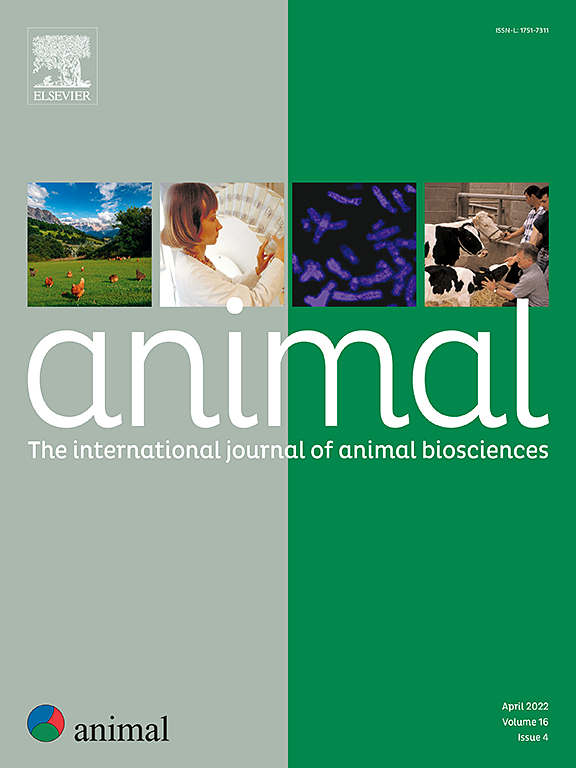Defatted black soldier fly larvae meal as a substitute of soybean meal in dairy cow diets
IF 4
2区 农林科学
Q1 AGRICULTURE, DAIRY & ANIMAL SCIENCE
引用次数: 0
Abstract
The replacement of soybean meal (SBM) with insect meal, e.g. black soldier fly larvae meal (BSFLM), as an alternative protein source in livestock feed is gaining traction globally. To date, no in vivo studies have been conducted to test the impact of BSFLM on the milk production of dairy cows. This study quantified the effects of replacing SBM with defatted black soldier fly larvae meal (DBSFLM) in diets of lactating dairy cows on feed intake, milk production and composition, apparent total-tract digestibility, feed- and nitrogen use efficiency. Twelve lactating Holstein-Friesian cows were used in a replicated 3 × 3 Latin square design (18 d per period) with 3 protein treatments: a diet containing SBM as the main protein source (control, SBM); a diet with a 50: 50 mixture of SBM and DBSFLM (SBM: DBSFLM, 50: 50); and a diet with DBSFLM (DBSFLM). Animals were blocked per Latin square based on milk yield (MY), and the amount of concentrate in the diets was adjusted for MY. Diets were provided as a total mixed ration and offered ad libitum. Our results showed no treatment effects (P > 0.05) on milk yield and composition. DM and organic matter (OM) intake were significantly higher (P ≤ 0.003) for cows fed SBM (17.6 and 16.2 kg/d, respectively) compared with DBSFLM (16.6 and 15.1 kg/d, respectively), while DM and OM intake of SBM: DBSFLM (17.5 and 16.0 kg/d, respectively) did not differ from SBM but were higher compared with DBSFLM. CP intake was significantly higher (P = 0.003) for cows fed SBM (2.68 kg/d) compared with both DBSFLM (2.50 kg/d) and SBM: DBSFLM (2.54 kg/d), while CP intake for SBM: DBSFLM did not differ from DBSFLM. Apparent total-tract digestibility of NDF and ADF were significantly lower (P ≤ 0.024) for cows fed SBM (46.7 and 45.6%, respectively) compared with DBSFLM (54.0 and 52.0%, respectively), with SBM: DBSFLM (51.0 and 49.7%, respectively) not differing from either diet. No treatment effects were observed for DM, OM, CP and ether extract digestibility, and feed and nitrogen use efficiency. Incorporating DBSFLM into dairy cow diets did not significantly compromise the milk yield and composition, suggesting its potential to reduce the reliance on SBM and contribute to circular food systems.
脱脂黑虻幼虫粉替代豆粕在奶牛饲粮中的应用。
用昆虫粉替代豆粕(SBM),如黑虻幼虫粉(BSFLM),作为牲畜饲料中的替代蛋白质来源,正在全球范围内获得关注。到目前为止,还没有进行体内研究来测试BSFLM对奶牛产奶量的影响。本研究量化了泌乳奶牛饲粮中脱脂黑虻幼虫粕(DBSFLM)对采食量、产奶量和乳成分、表观全道消化率、饲料和氮利用效率的影响。试验选用12头泌乳荷斯坦-弗里西亚奶牛,采用重复3 × 3拉丁方设计(每期18 d),采用3种蛋白质处理:以SBM为主要蛋白质来源的饲粮(对照组,SBM);SBM与DBSFLM的比例为50:50 (SBM: DBSFLM, 50:50);和含DBSFLM (DBSFLM)的饮食。根据产奶量(MY)对每拉丁平方的动物进行封堵,并根据MY调整饲粮中的精料量。试验日粮为全混合日粮,供随意使用。结果表明,处理对产奶量和乳成分无显著影响(P < 0.05)。饲粮SBM(分别为17.6和16.2 kg/d)的干物质和有机质采食量显著高于饲粮DBSFLM(分别为16.6和15.1 kg/d) (P≤0.003);饲粮SBM: DBSFLM(分别为17.5和16.0 kg/d)的干物质和有机质采食量与SBM无显著差异,但高于DBSFLM。饲粮SBM (2.68 kg/d)的粗蛋白质摄入量显著高于饲粮DBSFLM (2.50 kg/d)和饲粮SBM: DBSFLM (2.54 kg/d)的牛(P = 0.003),而饲粮SBM: DBSFLM的粗蛋白质摄入量与饲粮DBSFLM的粗蛋白质摄入量无显著差异。饲粮SBM(分别为46.7%和45.6%)的NDF和ADF表观全道消化率显著低于饲粮DBSFLM(分别为54.0%和52.0%)(P≤0.024),其中SBM: DBSFLM(分别为51.0%和49.7%)与两种饲粮无显著差异。各处理对DM、OM、CP和粗脂肪消化率以及饲料和氮的利用效率均无影响。将DBSFLM添加到奶牛日粮中不会显著影响牛奶产量和成分,这表明它有可能减少对SBM的依赖,并有助于循环食品系统。
本文章由计算机程序翻译,如有差异,请以英文原文为准。
求助全文
约1分钟内获得全文
求助全文
来源期刊

Animal
农林科学-奶制品与动物科学
CiteScore
7.50
自引率
2.80%
发文量
246
审稿时长
3 months
期刊介绍:
Editorial board
animal attracts the best research in animal biology and animal systems from across the spectrum of the agricultural, biomedical, and environmental sciences. It is the central element in an exciting collaboration between the British Society of Animal Science (BSAS), Institut National de la Recherche Agronomique (INRA) and the European Federation of Animal Science (EAAP) and represents a merging of three scientific journals: Animal Science; Animal Research; Reproduction, Nutrition, Development. animal publishes original cutting-edge research, ''hot'' topics and horizon-scanning reviews on animal-related aspects of the life sciences at the molecular, cellular, organ, whole animal and production system levels. The main subject areas include: breeding and genetics; nutrition; physiology and functional biology of systems; behaviour, health and welfare; farming systems, environmental impact and climate change; product quality, human health and well-being. Animal models and papers dealing with the integration of research between these topics and their impact on the environment and people are particularly welcome.
 求助内容:
求助内容: 应助结果提醒方式:
应助结果提醒方式:


